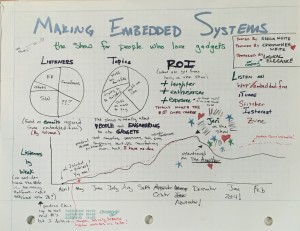I go to the occasional women-in-tech things. I’ve been to Grace Hopper, once as attendee, once as a speaker/manager bringing her team. I read Systers for years but don’t currently, it is just too much sometimes.
Actually, that sums up my feelings about women-in-tech events pretty well: it is just too much sometimes. And yet.
I like to attend women-in-tech things because it is nice to see women happy as engineers. Too many times, I hear the horror stories. But there are many people, many women, untouched (or only slightly touched) by the trolls, stalkers, and jerks of the internet. I like to be reminded that it isn’t always awful.
And I go because I get a little lonely in my job sometimes. I like to connect with people who might be in the same boat, maybe offer some advice to those more junior in their career, maybe receive some advice from those more senior.
I also go to find podcast guests. I’m not shy in trying to get a gender balanced podcast despite the lack of gender balance in embedded systems. That means I have to search a little more, work a little harder to get women guests. So I go to women-in-tech meetups hoping to find people.
Though, I’m fairly terrible (stressed) in crowds and I find that seems to be getting worse as I get older. I can pretend to be an extrovert for about 4.5 minutes (8 with alcohol). Then I get jittery and want to throw up. Reeeeallllly Jekyll and Hyde-y.
I went to an event this week. It was ok. There was no alcohol. And the demos (from the hosting company) were done by men (though they were nice, it just seemed like a missed opportunity to highlight some women’s achievements). At least the talks were done by interesting, engaging women… though they were a little long. As someone there for the networking (4.5 minutes of it anyway), I don’t want detailed technical presentations.
It got me thinking about what I’d want to do if I was putting on a women-in-tech event. So let me write these ideas down, maybe it will plant a seed for later.
1. There shall be alcohol. All networking events should have beer and wine.
2. Food will be primarily vegan. Because, crap, I’m tired of not being sure what is safe for my socially-nervous and vegetarian stomach to eat. Maybe steak strips or meatballs too, but everything else will be vegan. Sometimes at these things all I want is a little peanut butter and jelly sandwich. And there will be dessert but it will served later (halfway through), not set out with the food. Dessert doesn’t have to be all vegan.
3. There will be seating but not quite enough of it.
4. For a 3 hour event, there will be four to six 5-minute talks, three at T+30min hour, three at T+65min. The goal of the talks is to create discussion and getting people to talk to each other, not to give speakers platforms. The talks act as ice breakers, the speakers will know that.
5. Badges will have first names only. There will be small stickers for different interests. If it is hosted by a company, they will have small stickers so it is easy to pick out people who work there.
6. There will be different themes in different parts of the room. They will be clearly marked: “I’d love to meet you” (seating and food), “We’d love for you to join our conversation” (seating), “We’re happy in our conversation, give us a minute” (tables but no seating). People won’t have to declare themselves, just stand in the right place. Ok, this one is sort of dumb. Maybe scratch it out and put in a networking/mixer game thingy.
7. It will be a women in tech focused event but open to anyone who wants to support getting more women interested and retained in engineering, math, technology, and science. You do not have to identify as female to come.
8. There will be a few people who are asked specifically to act as hosts, who spend the evening meeting people then introducing them to each other.
9. We will make some horrible mistake against feminism (giving out lipstick, having men do demos, handing out hot pink rape whistles) so that everyone can be aghast at something.
Oh no! We’ve reach the cynicism level. Don’t go deeper, it gets very dark in there.
I’ve been to great meetups, both gendered and not specific. One GirlGeekDinner was fantastic, another one I was lost at. The OSHPark Bring a Hack Maker Fair after party is pretty amazing: Laen gets people there and mingling with each other. Some of that is because they are fascinating people and because we’re told to bring something which creates an icebreaker. But there is something else too.
I don’t know what that something else is. I suppose if I did, I’d bottle it and make millions.
Anyway, there are many women-in-tech things and something always goes oddly but I’m not ready to give up on them yet. Though I’m not ready to throw my own either.


